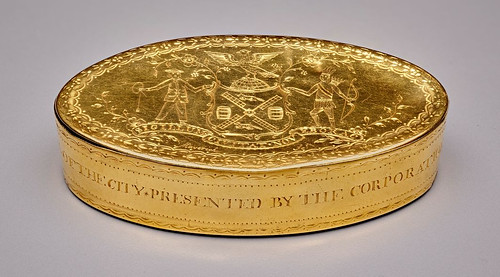
PREV ARTICLE
NEXT ARTICLE
FULL ISSUE
PREV FULL ISSUE
V25 2022 INDEX E-SYLUM ARCHIVE YALE'S GOLD IN AMERICA EXHIBITThe Wall Street Journal article reviews a Yale University Art Gallery exhibit in gold in America. Here's an excerpt. -Editor
At the Yale University Art Gallery, the current show
This is not a glittery exhibition, but one that glows serenely. Many of the beautiful objects presented here, including gold tableware, medals, betrothal and mourning rings, fraternal badges, and other jewelry, embody the exceptional craftsmanship and artistry that the metal inspired as well as the techniques of traditional goldsmithing that went into their creation. Of more public historical significance is the gold freedom box awarded to Revolutionary War hero Baron Friedrich Wilhelm von Steuben, the Prussian officer who helped whip George Washington's ragtag Continental Army into a disciplined military force. Freedom boxes were the equivalent of a key to the city, and this one, wrought by American goldsmith Samuel Johnson and beautifully engraved by Peter Rushton Maverick, was commissioned by the City of New York in 1784 in gratitude for Steuben's efforts. From a technical standpoint, the box represents the earliest known employment of bright-cut decoration in American goldsmithing. Bright cutting, which became definitive of Federal-style metalwork, is a technique of incising short, angled strokes with a polished engraving tool into gold, silver or copper, then burnishing the resulting planes to achieve a sparkling effect.
Not all that shines here is made of gold. Among the curiosities is not an actual gold piece but a proof of a circa 1889 $100 gold certificate, a prototype bank note. Issued for public circulation from 1863 to 1933, gold certificates declared that the bearer could redeem them at a bank for the face value in actual gold coin. This design is ironic, because it features a portrait of Missouri Sen. Thomas Hart Benton, known in his day as It is shown together with two of the most beautiful of all American gold coins. Both were commissioned by President Theodore Roosevelt, who wanted the U.S. Mint to raise the artistic standard of American coinage to that of ancient Greece. The celebrated $20 double eagle, with its obverse figure of striding Liberty, was issued from 1907 to 1933. Originally designed in high relief by sculptor Augustus Saint-Gaudens, it was modified in lower relief for practicable coinage production by the U.S. Mint's chief engraver Charles E. Barber. The $5 half eagle, designed by Saint-Gaudens's pupil Bela Lyon Pratt, was minted (with interruptions) from 1908 to 1929. Instead of modeling the obverse profile of a Native American in relief according to convention, Pratt designed it like an intaglio, with the head (and the eagle on the reverse) incused. Like Saint-Gaudens's coin, Pratt's also had to be modified by Barber.
To read the complete article (subscription required), see:
Wayne Homren, Editor The Numismatic Bibliomania Society is a non-profit organization promoting numismatic literature. See our web site at coinbooks.org. To submit items for publication in The E-Sylum, write to the Editor at this address: whomren@gmail.com To subscribe go to: https://my.binhost.com/lists/listinfo/esylum All Rights Reserved. NBS Home Page Contact the NBS webmaster 
|

